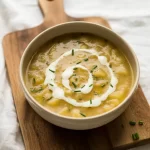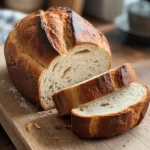I finally perfected my Homemade French Bread and I’m sharing the surprising kitchen trick behind it.

I used to think perfect French bread was only something you bought at a bakery, but I kept tinkering until I finally got one that makes me do a double take. The crust shatters and the inside stays soft and airy, every single time.
I use bread flour and active dry yeast, plus a tiny tip that gives that bakery crust, you wont believe how easy it is. It bakes into a long, rustic loaf that makes sandwiches taste better and pasta dinners feel fancier.
This is my Easy Crusty French Bread, the loaf I brag about then hide from guests.
Ingredients

- Flour gives structure and carbs, some protein, less fiber if you use white flour.
- Yeast ferments sugars, produces gas for rise, adds subtle bready, slightly tangy flavor.
- Warm water hydrates flour, activates yeast gently, affects dough temperature and texture.
- Salt controls fermentation, strengthens gluten, enhances flavor, its essential but use sparingly.
- Sugar or honey feeds yeast, speeds the rise, adds mild sweetness and helps crust brown.
- Oil tenderizes the crumb, adds richness and moisture, small amounts boost softness.
- Cornmeal or flour dusting prevents sticking, gives a bit of crunch and rustic look.
Ingredient Quantities
- 4 cups (480 g) bread flour or all purpose flour
- 1 1/4 cups (300 ml) warm water, about 105 to 115 F
- 2 1/4 tsp (1 packet, 7 g) active dry yeast
- 1 tbsp granulated sugar or honey
- 2 tsp fine sea salt
- 1 tbsp olive oil or vegetable oil (optional, makes crumb a bit softer)
- Extra flour or cornmeal for dusting (optional)
How to Make this
1. Pour 1 1/4 cups (300 ml) warm water (105 to 115 F) into a bowl, stir in 1 tbsp sugar or honey and 2 1/4 tsp (7 g) active dry yeast, let sit 5 to 10 minutes until foamy.
2. In a large bowl mix 4 cups (480 g) flour and 2 tsp fine sea salt (keep the salt away from the yeast while it’s blooming), add 1 tbsp oil if you want a softer crumb.
3. Pour the foamy yeast mixture into the flour, stir with a wooden spoon until a shaggy dough forms, scrape it out onto a lightly floured surface.
4. Knead about 8 to 10 minutes by hand until smooth and elastic and it passes a rough windowpane test, or 5 to 7 minutes in a mixer with a dough hook; add tiny sprinkles of flour only if it’s way too sticky.
5. Lightly oil a bowl, place the dough inside, cover with plastic wrap or a damp towel, let rise in a warm spot until doubled, about 1 hour, don’t rush it or the crumb will be tight.
6. Punch the dough down gently, shape into 2 long loaves or 1 large loaf by rolling and tucking seams under, dust a parchment or peel with extra flour or cornmeal so they won’t stick.
7. Put shaped loaves on the prepared surface, cover loosely and let rise again 30 to 45 minutes until puffy, preheat oven to 450 F (230 C) with a baking stone or heavy sheet inside and a shallow metal pan on the bottom rack.
8. Just before baking score the loaves with a sharp blade at a 45 degree angle, slide them onto the hot stone or sheet, then quickly pour 1 cup boiling water into the hot pan on the bottom rack (or add a few ice cubes) to create steam for the first part of baking.
9. Bake 12 to 15 minutes with the steam, then remove the water pan and continue baking another 8 to 12 minutes until deep golden and crusty and the loaf sounds hollow when tapped (or 200 to 210 F internal temp).
10. Cool on a wire rack at least 20 to 30 minutes before slicing so the inside sets, and remember: steam is the secret for a super crisp crust and the optional tablespoon of oil will give you a softer, fluffier inside.
Equipment Needed
1. Large mixing bowl for the flour and dough
2. Small bowl or glass measuring cup to proof the yeast
3. Measuring cups and spoons plus a kitchen scale for accuracy
4. Wooden spoon or dough whisk to stir the shaggy dough
5. Stand mixer with dough hook if you dont wanna knead by hand
6. Bench scraper or sturdy spatula to scrape and shape the dough
7. Baking stone or heavy baking sheet preheated in the oven
8. Parchment paper or a well floured pizza peel dusted with cornmeal
9. Sharp blade or lame for scoring the loaves
10. Shallow metal pan for steaming, oven mitts and a wire cooling rack
FAQ
Easy Homemade French Bread Recipe Substitutions and Variations
- Flour: all purpose works fine if you don’t have bread flour, use the same amount but loaf will be a bit less chewy; or swap up to 25% whole wheat for nuttier flavor but add about 2 tbsp more water; or mix in 1 to 2 tbsp vital wheat gluten to AP to get a stronger dough.
- Yeast: instant/rapid rise replaces active dry (use about 25% less and you can mix it straight into the flour), or fresh cake yeast at roughly 3 times the weight of dry yeast dissolved in water, or use 100 g active sourdough starter instead but expect much longer rise times.
- Sweetener: granulated sugar is 1 to 1 with honey, maple syrup or agave work too just cut total liquid by about 1 tbsp per tbsp of syrup, molasses gives deeper flavor so use a little less.
- Oil: swap equal amount melted butter for richer crumb, use any neutral oil like canola, or leave it out completely for a crisper crust.
Pro Tips
– Weigh the flour, dont eyeball cups. Bakers who switch to a scale get way more consistent loaves, no more dense surprises.
– Always check the yeast by proofing it first. If it never gets foamy in 10 minutes toss it, old yeast gives sluggish rise and a tight crumb.
– Knead by feel not by time. You want a smooth, slightly tacky dough that stretches thin without tearing when you try the windowpane test, stop when it behaves not when the clock says so.
– Get that steam in fast and be careful. Preheat your stone or sheet so the loaf hits a hot surface, then add boiling water or a few ice cubes to the pan and close the door quick. The steam gives the crust lift, but steam will burn you if you fumble.
– Score with confidence at about a 45 degree angle and let the bread cool fully before slicing. If you undercut or wait too little the crumb will be gummy, so be patient its worth it.

Easy Homemade French Bread Recipe
I finally perfected my Homemade French Bread and I’m sharing the surprising kitchen trick behind it.
12
servings
162
kcal
Equipment: 1. Large mixing bowl for the flour and dough
2. Small bowl or glass measuring cup to proof the yeast
3. Measuring cups and spoons plus a kitchen scale for accuracy
4. Wooden spoon or dough whisk to stir the shaggy dough
5. Stand mixer with dough hook if you dont wanna knead by hand
6. Bench scraper or sturdy spatula to scrape and shape the dough
7. Baking stone or heavy baking sheet preheated in the oven
8. Parchment paper or a well floured pizza peel dusted with cornmeal
9. Sharp blade or lame for scoring the loaves
10. Shallow metal pan for steaming, oven mitts and a wire cooling rack
Ingredients
-
4 cups (480 g) bread flour or all purpose flour
-
1 1/4 cups (300 ml) warm water, about 105 to 115 F
-
2 1/4 tsp (1 packet, 7 g) active dry yeast
-
1 tbsp granulated sugar or honey
-
2 tsp fine sea salt
-
1 tbsp olive oil or vegetable oil (optional, makes crumb a bit softer)
-
Extra flour or cornmeal for dusting (optional)
Directions
- Pour 1 1/4 cups (300 ml) warm water (105 to 115 F) into a bowl, stir in 1 tbsp sugar or honey and 2 1/4 tsp (7 g) active dry yeast, let sit 5 to 10 minutes until foamy.
- In a large bowl mix 4 cups (480 g) flour and 2 tsp fine sea salt (keep the salt away from the yeast while it's blooming), add 1 tbsp oil if you want a softer crumb.
- Pour the foamy yeast mixture into the flour, stir with a wooden spoon until a shaggy dough forms, scrape it out onto a lightly floured surface.
- Knead about 8 to 10 minutes by hand until smooth and elastic and it passes a rough windowpane test, or 5 to 7 minutes in a mixer with a dough hook; add tiny sprinkles of flour only if it's way too sticky.
- Lightly oil a bowl, place the dough inside, cover with plastic wrap or a damp towel, let rise in a warm spot until doubled, about 1 hour, don't rush it or the crumb will be tight.
- Punch the dough down gently, shape into 2 long loaves or 1 large loaf by rolling and tucking seams under, dust a parchment or peel with extra flour or cornmeal so they won't stick.
- Put shaped loaves on the prepared surface, cover loosely and let rise again 30 to 45 minutes until puffy, preheat oven to 450 F (230 C) with a baking stone or heavy sheet inside and a shallow metal pan on the bottom rack.
- Just before baking score the loaves with a sharp blade at a 45 degree angle, slide them onto the hot stone or sheet, then quickly pour 1 cup boiling water into the hot pan on the bottom rack (or add a few ice cubes) to create steam for the first part of baking.
- Bake 12 to 15 minutes with the steam, then remove the water pan and continue baking another 8 to 12 minutes until deep golden and crusty and the loaf sounds hollow when tapped (or 200 to 210 F internal temp).
- Cool on a wire rack at least 20 to 30 minutes before slicing so the inside sets, and remember: steam is the secret for a super crisp crust and the optional tablespoon of oil will give you a softer, fluffier inside.
Notes
- Below you’ll find my best estimate of this recipe’s nutrition facts. Treat the numbers as a guide rather than a rule—great food should nourish both body and spirit. Figures are approximate, and the website owner assumes no liability for any inaccuracies in this recipe.
Nutrition Facts
- Serving Size: 68.6g
- Total number of serves: 12
- Calories: 162kcal
- Fat: 1.57g
- Saturated Fat: 0.17g
- Trans Fat: 0g
- Polyunsaturated: 0.13g
- Monounsaturated: 0.83g
- Cholesterol: 0mg
- Sodium: 323mg
- Potassium: 42.8mg
- Carbohydrates: 31.5g
- Fiber: 1.08g
- Sugar: 1.04g
- Protein: 4.29g
- Vitamin A: 0IU
- Vitamin C: 0mg
- Calcium: 6mg
- Iron: 1.88mg
















